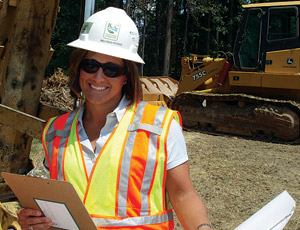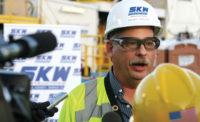
Melinda Peters is the first to say that successful construction projects are the result of teamwork, not the actions of a single person. But as the Maryland State Highway Administration’s project director for the $2.6-billion, 18.8-mile Inter County Connector (ICC), Peters nevertheless finds herself continually in the spotlight as the human face of the largest, greenest and most controversial highway to be built in metropolitan Washington, D.C., in decades.
The ICC, which got under way in 2007 after nearly a half-century of studies, lawsuits, and often contentious debate, epitomizes the nation’s approach to environmental stewardship in the 21st Century. For example, 15% of its budget is devoted to environmental mitigation and enhancement, ranging from streambank protection and stormwater management to reforestation and relocation of rare turtles.
Peters coordinates the efforts of three design-build teams and keeps the project on time and on budget by balancing the interests of contractors, consultants, regulatory agencies, politicians and the public. Despite the vagaries of weather, which included 12 months of record rainfall followed by multiple major blizzards, the ICC has remained largely on schedule, with the first 7.2-mile segment set to open on schedule by early 2011.
“Melinda is totally focused on what’s best for the project,” observes Dave Miles, executive vice president with Kiewit Infrastructure Gwroup, which leads the MD200 Constructors joint-venture design-build team. “Rather than getting caught up in assigning blame for something, she proactively looks for solutions that will keep the project moving forward.”
That Peters has been able to tackle the formidable ICC at the relatively young age of 37 comes as no surprise to SHA administrator Neil Pedersen. “Melinda has the unique ability to see the issues on a project as large and complex as the ICC—from the highest conceptual level down to the most detailed engineering issue—and find solutions that will satisfy all the parties involved,” he says.
Peters also has taken it upon herself to represent the ICC to a sometimes volatile public. Because subdivisions grew up alongside the ICC’s vacant right-of-way during the decades of debate, many residents have seen their backyards transformed from woodland and fields to construction zones. By frequently addressing community groups and responding to most citizen complaints personally, Peters has helped “sell” the ICC to the public, finding ways to appease some concerns and explain why some elements of the project simply cannot be changed.
Bill Cox, president of Corman Construction Inc., part of the Intercounty Constructors design-build team, credits Peters’ ability to consider the interests of a large and diverse clientele while overseeing the day-to-day intricacies of managing a large project team. “I truly admire her for being able to keep so many balls in the air,” Cox says.



Post a comment to this article
Report Abusive Comment